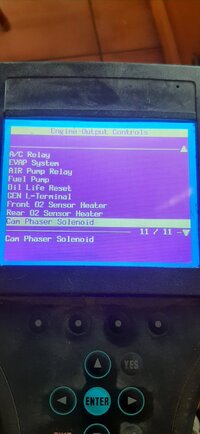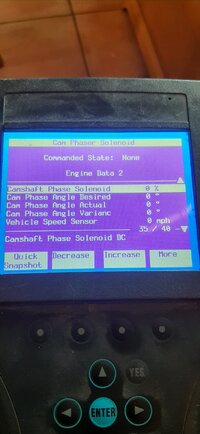The problem here is that trying to either reach or maintain any Specific Cam Phaser position to establish a steady-state helical or mechanical Angle of Advance or Retard of the Exhaust Camshaft is next to impossible. This is because unlike any and all other Atlas 4,5,6 Cylinder sensors… the Cam Phaser position varies at any given moment of operation and is directly subject to the Infinite Variability of Engine Oil Pressure in the Early Model Atlas Motors.
These changing conditions with the CPAS are too random to be able to nail down to a rational quantity useful in designing a PID beyond knowing what the Cam Phaser Angle looks like at any given moment. This measurement is NOT the same thing as knowing what the ACTUAL Exhaust Camshaft Position is with any precision. So if the idea is to design a PID that can extract what THAT specific measurement is… the CPS information would probably be the more relevant of the two.
The secondary beneficial effect of the Cam Phaser acting like an EGR at Low RPM is probably the biggest concern to the PCM. The improvements in the Power and Torque are likewise needing Exhaust Camshaft adjustments in the upper RPM band. But, another ‘variable’ at play affecting this will be the presence of a Badly Worn Timing Set which can confuse the entire set up, Once the ACTUAL position of the Crankshaft cannot be determined in relation to the EXPECTED Position of the Camshaft, this “reference decay” will come into play as yet another unpredictable variable confusing things.
ALL GM Atlas 4.2L Engines have unique and different kinds of Wear and Tear patterns on the Rotating Assembly where More or Less Oil Pressure might be available depending upon the Engine Condition and Performance in all RPM Ranges affected by the position of the Cam Phaser. What that turns out to be, moment by moment, will largely depend upon the Type, Viscosity, Cleanliness and Availability of the Motor Oil being circulated under variable dynamic pressure.
The ability of that Oil to travel up from the bottom of the Crankcase vacuumed into and through the Oil Pick Up Screen and then being cycled through the Gerotor Oil Pump depends upon its freedom from obstruction and blockage. The Old Adage, “You Can’t Make Bricks Without Straw…” definitely applies where the Oil Pressure of the entire system is compromised by this reality… and the diminished performance of the Cam Phaser will happen as a result of this reduction in Oil Pressure in ALL RPM Ranges.
Additionally, If the engine suffers from Excessive Wear and Tear of the Mains and Con-Rods Bearings, Oil Pressure Bleed Down will occur in the loose gap in between the Crank and Con-Rod bearings and their Journals. How much Motor Oil will be able to pass into and out of the Early Model Helical Design Cam Phaser under Pressure under these conditions is yet another variable to consider.
Whatever the Camshaft Position Actuator Solenoid ATTEMPTS to achieve, moment by moment depends upon so many other factors and variables that will be different from one engine and the next. Therefore a simple measurement cannot be settled upon and used to adjust the PCM Programming CPAS Base Line. Knowing what the ACTUAL POSITION of the Exhaust Cam is within its narrow adjustable band of movement from 0-25 Degrees will be difficult to derive using any “fixed” numbers.
Other than being able to see a a COMPLETE Lack of Change in its position due to a Total Failure of the Cam Phaser... The Question that Begs is: “What purpose does knowing the Cam Phaser Angle Serve?


